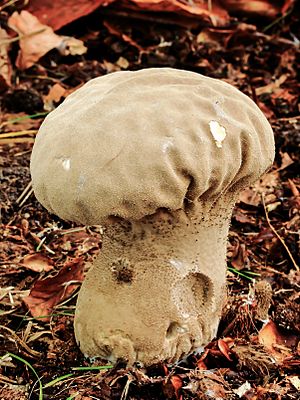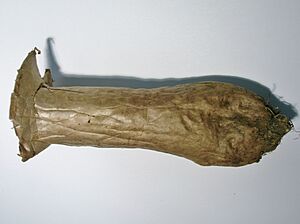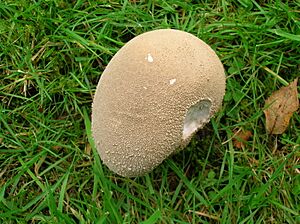Handkea excipuliformis facts for kids
Handkea excipuliformis, also known as the pestle puffball or long-stemmed puffball, is a type of fungus in the family Agaricaceae. It's a fairly large puffball mushroom that can grow up to 15 centimeters (about 6 inches) wide and 25 centimeters (about 10 inches) tall. You can find it in many northern areas with mild climates, often in fields and sandy open lands.
Quick facts for kids Handkea excipuliformis |
|
|---|---|
 |
|
| Scientific classification | |
| Kingdom: | |
| Division: | |
| Class: | |
| Order: |
Agaricales
|
| Family: |
Agaricaceae
|
| Genus: |
Handkea
|
| Species: |
H. excipuliformis
|
| Binomial name | |
| Handkea excipuliformis (Bull.) Kreisel
|
|
| Synonyms | |
Lycoperdon polymorphum var. excipuliforme
|
|
Contents
What is a Pestle Puffball?
Like all puffballs, the pestle puffball produces its spores inside its body. These spores are tiny reproductive cells, like seeds for plants. They are only released when the mushroom gets old and dry, or when something breaks it open.
How to Spot a Pestle Puffball
Young pestle puffballs are usually 6 to 12 centimeters (about 2.5 to 5 inches) wide. They start out white or a light grey-brown color. When they are fully grown, they can be as big as 15 centimeters (6 inches) wide and 25 centimeters (10 inches) tall.
The bottom part of the puffball is connected to the ground by root-like threads called rhizomorphs. These threads help the mushroom get nutrients.
Parts of the Puffball
This mushroom has two main parts:
- The Head: This is the upper, round part. It's white at first and then turns a yellowish-brown as it gets older. When it's young, it has soft, pointed bumps on its surface. These bumps fall off, leaving a smooth, dull surface. The spores grow inside this rounded head.
- The Stipe (Stem): This is the lower, stem-like part. It's spongy and can look wrinkled. It starts white with pointed bumps, but later turns yellowish-brown and becomes smooth and tough like leather.
When the head breaks open and releases the spores, the stem part stays behind. It can even last through the winter and into the next summer!
Puffball Spores
The inside of the puffball, where the spores are, is called the gleba. At first, the gleba is white. As the mushroom matures, it turns olive green and then a purplish-brown. The spores themselves are tiny, round, and bumpy, measuring about 3.5 to 5.5 micrometers. They are released into the air, often helped by rain or by animals stepping on the mushroom.
Where Does the Pestle Puffball Grow?
You can find the pestle puffball commonly from late summer to autumn. It grows alone or in small groups in rich soil in both pine and broadleaf woodlands, as well as in short grassy areas. It's often seen under hedges, in unused land, and in all kinds of woods, especially at the edges of clearings.
Can You Eat the Pestle Puffball?
Yes, this fairly large puffball is edible, but only when it's young and the inside flesh is completely white. If the inside has started to turn yellow, olive, or brown, it's too old to eat. The taste and smell are not very strong. It tastes similar to the giant puffball, but its flesh is a bit softer, and you should remove the outer skin before cooking.
Similar Mushrooms
The mushroom called Handkea perlatum is much smaller than the pestle puffball. It also has a shorter stem, and when you rub off the bumps from its cap, it leaves a mesh-like pattern.
See also
 In Spanish: Lycoperdon excipuliforme para niños
In Spanish: Lycoperdon excipuliforme para niños



